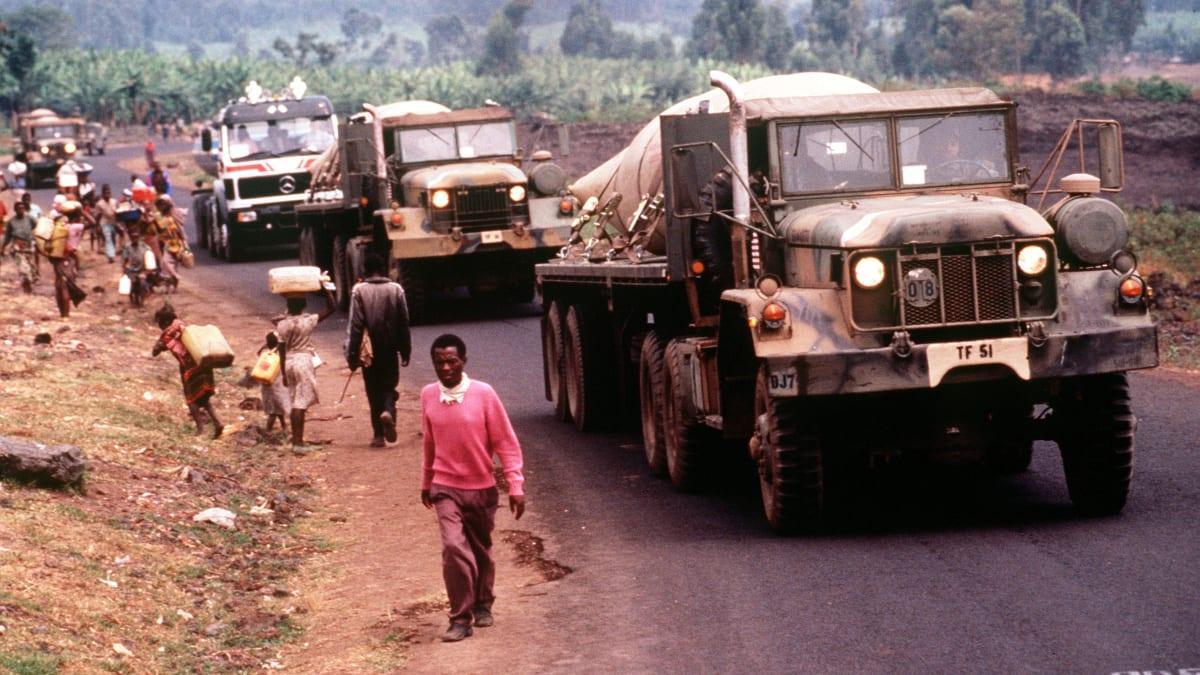
More About Violence erupts in Rwanda, foreshadowing genocide
On April 7, 1994, violence fuels the launch of what would become the worst episode of genocide since World War II: the massacre of an estimated 500,000 to 1 million innocent civilian Tutsis and moderate Hutus. Following the first wave of massacres, Rwandan forces manage to discourage international intervention with the murder of 10 Belgian peacekeeping officers. The Tutsis, a minority group that made up about 10 percent of Rwanda’s population, received no assistance from the international community, although the United Nations later conceded that a mere 5,000 soldiers deployed at the outset would have stopped the wholesale slaughter.
The immediate roots of the 1994 genocide dated back to the early 1990s, when President Juvenal Habyarimana, a Hutu, began using anti-Tutsi rhetoric to consolidate his power among the Hutus. Beginning in October 1990, there were several massacres of hundreds of Tutsis. Although the two ethnic groups were very similar, sharing the same language and culture for centuries, the law required registration based on ethnicity. The government and army began to assemble the Interahamwe (meaning “those who attack together”) and prepared for the elimination of the Tutsis by arming Hutus with guns and machetes. In January 1994, the United Nations forces in Rwanda warned that larger massacres were imminent.
On April 6, 1994, President Habyarimana was killed when his plane was shot down. It is not known if the attack was carried out by the Rwandan Patriotic Front (RPF), a Tutsi military organization stationed outside the country at the time, or by Hutu extremists trying to instigate a mass killing. In any event, Hutu extremists in the military, led by Colonel Theoneste Bagosora, immediately went into action, murdering Tutsis and moderate Hutus within hours of the crash.
The Belgian peacekeepers were killed the next day, a key factor in the withdrawal of U.N. forces from Rwanda. Soon afterward, the radio stations in Rwanda were broadcasting appeals to the Hutu majority to kill all Tutsis in the country. The army and the national police directed the slaughter, sometimes threatening Hutu civilians when persuasion didn’t work. Thousands of innocent people were hacked to death with machetes by their neighbors. Despite the horrific crimes, the international community, including the United States, hesitated to take any action. They wrongly ascribed the genocide to chaos amid tribal war. President Bill Clinton later called America’s failure to do anything to stop the genocide “the biggest regret” of his administration.
It was left to the RPF, led by Paul Kagame, to begin an ultimately successful military campaign for control of Rwanda. By the summer, the RPF had defeated the Hutu forces and driven them out of the country and into several neighboring nations. However, by that time, an estimated 75 percent of the Tutsis living in Rwanda had been murdered.
The immediate roots of the 1994 genocide dated back to the early 1990s, when President Juvenal Habyarimana, a Hutu, began using anti-Tutsi rhetoric to consolidate his power among the Hutus. Beginning in October 1990, there were several massacres of hundreds of Tutsis. Although the two ethnic groups were very similar, sharing the same language and culture for centuries, the law required registration based on ethnicity. The government and army began to assemble the Interahamwe (meaning “those who attack together”) and prepared for the elimination of the Tutsis by arming Hutus with guns and machetes. In January 1994, the United Nations forces in Rwanda warned that larger massacres were imminent.
On April 6, 1994, President Habyarimana was killed when his plane was shot down. It is not known if the attack was carried out by the Rwandan Patriotic Front (RPF), a Tutsi military organization stationed outside the country at the time, or by Hutu extremists trying to instigate a mass killing. In any event, Hutu extremists in the military, led by Colonel Theoneste Bagosora, immediately went into action, murdering Tutsis and moderate Hutus within hours of the crash.
The Belgian peacekeepers were killed the next day, a key factor in the withdrawal of U.N. forces from Rwanda. Soon afterward, the radio stations in Rwanda were broadcasting appeals to the Hutu majority to kill all Tutsis in the country. The army and the national police directed the slaughter, sometimes threatening Hutu civilians when persuasion didn’t work. Thousands of innocent people were hacked to death with machetes by their neighbors. Despite the horrific crimes, the international community, including the United States, hesitated to take any action. They wrongly ascribed the genocide to chaos amid tribal war. President Bill Clinton later called America’s failure to do anything to stop the genocide “the biggest regret” of his administration.
It was left to the RPF, led by Paul Kagame, to begin an ultimately successful military campaign for control of Rwanda. By the summer, the RPF had defeated the Hutu forces and driven them out of the country and into several neighboring nations. However, by that time, an estimated 75 percent of the Tutsis living in Rwanda had been murdered.
Did you know you can follow any of our 175 Special Interest calendars and stay informed better than ever before? See them here. You can also create your own public or private calendar here. Post events to your calendar and ours at the same time! Terms and conditions may vary based on the policies of your local Town Planner publisher.
To learn more, watch our intro video!